Advertisement |
 |
Do you have a career question?
The Naturejobs podcast features one-on-one Q&As, panel discussions and other exclusive content to help scientists with their careers. Hosted on the Naturejobs blog, the podcast is also available on iTunes and Soundcloud.
Listen today! |  | | |
 |
 |
TABLE OF CONTENTS
|
| March 2018 Volume 10, Issue 3 |
 |  |  |
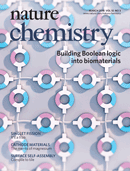 |  News and Views News and Views
 Correction Correction
 Articles Articles
 In Your Element In Your Element
| |
 |
| |
 |
 |
| Advertisement |
 |
Nature Catalysis is an online-only journal that publishes research, review and comment across all areas of catalysis.
EXPLORE THE LATEST ISSUE >> |  | | |
 |
| |
Advertisement |
 |
| npj Materials Degradation is a new open access journal that is now open for submissions. The journal publishes the finest content describing basic and applied research discoveries in the area of corrosion (degradation) and protection of materials. |  | | |
 |
| |
News and Views |  Top Top |
 |
 |
 |
| |
 |
Correction |  Top Top |
 |
 |
 |
| Correction p249
doi:10.1038/nchem.2939
|
 |
Articles |  Top Top |
 |
 |
 |
| Engineered modular biomaterial logic gates for environmentally triggered therapeutic delivery pp251 - 258
Barry A. Badeau, Michael P. Comerford, Christopher K. Arakawa, Jared A. Shadish and Cole A. DeForest
doi:10.1038/nchem.2917
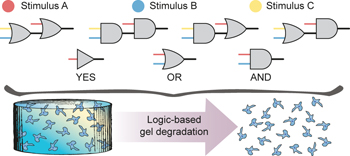
Biomaterials that respond to precise combinations of environmental cues represent an important technology for tissue engineering and next-generation drug delivery systems. Now, a modular framework to programme material degradation following Boolean logic has been demonstrated by specifying the molecular architecture and connectivity of orthogonal stimuli-labile moieties within hydrogel cross-linkers.
|
 |
 |
 |
| The role of uranium–arene bonding in H2O reduction catalysis pp259 - 267
Dominik P. Halter, Frank W. Heinemann, Laurent Maron and Karsten Meyer
doi:10.1038/nchem.2899
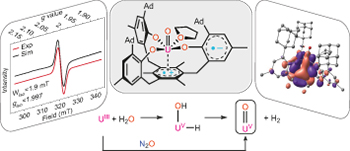
An arene-anchored uranium(III) complex that facilitates the electrocatalytic formation of H2 from H2O has now been shown to involve redox-cooperativity between the uranium centre and its covalently bound mesitylene ligand. The oxidative addition of H2O to the uranium catalyst is a concerted two-electron reaction — atypical for f-block metals.
Chemical compounds
See also: News and Views by Mazzanti |
 |
 |
 |
| Evaluating differences in the active-site electronics of supported Au nanoparticle catalysts using Hammett and DFT studies pp268 - 274
Gaurav Kumar, Luke Tibbitts, Jaclyn Newell, Basu Panthi, Ahana Mukhopadhyay et al.
doi:10.1038/nchem.2911
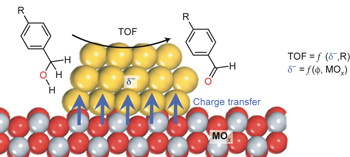
Understanding how a supporting material can change the surface chemistry of the nanoparticle catalysts that it hosts is critical to tuning catalytic properties. Experimental Hammett studies and density functional theory calculations show that differences in reactivity can be attributed to differences in the electron density at metal active sites, which arises from differences in electron donation from the support.
|
 |
 |
 |
| De novo design and engineering of non-ribosomal peptide synthetases pp275 - 281
Kenan A. J. Bozhüyük, Florian Fleischhacker, Annabell Linck, Frank Wesche, Andreas Tietze et al.
doi:10.1038/nchem.2890
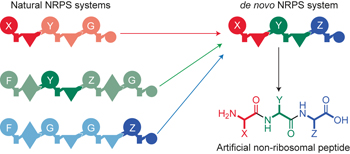
Peptides derived from non-ribosomal peptide synthetases (NRPS) are an important class of pharmaceutically relevant drugs. However, no general rules for the modification of NRPS or the generation of artificial NRPS are known. Now, a new strategy for the modification of NRPS has been developed that uses defined exchange units that are fused at specific positions connecting the condensation and adenylation domains.
See also: News and Views by Menon & Jenner |
 |
 |
 |
| Nonribosomal biosynthesis of backbone-modified peptides pp282 - 287
David L. Niquille, Douglas A. Hansen, Takahiro Mori, David Fercher, Hajo Kries et al.
doi:10.1038/nchem.2891
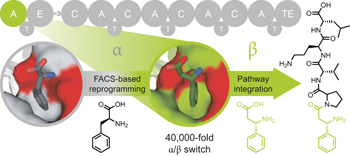
Nonribosomal peptide synthetases (NRPSs) produce vital natural products but have proven recalcitrant to biosynthetic engineering. Now, a combination of yeast surface display and fluorescence-activated cell sorting (FACS) has been used to reprogram an L-Phe-incorporating module for ?-Phe. The resulting module is highly selective and functions efficiently in NRPS pathways.
See also: News and Views by Menon & Jenner |
 |
 |
 |
| Oxygen redox chemistry without excess alkali-metal ions in Na2/3[Mg0.28Mn0.72]O2 pp288 - 295
Urmimala Maitra, Robert A. House, James W. Somerville, Nuria Tapia-Ruiz, Juan G. Lozano et al.
doi:10.1038/nchem.2923

Alkali-metal-rich compositions (for example, Li[LixM1–x]O2) are promising battery cathode materials that exhibit oxygen redox, which provides additional charge capacity. It is thought to occur in compounds containing alkali ions in the transition metal layers and featuring Li+–O(2p)–Li+ interactions; however, now it is observed in Na2/3[Mg0.28Mn0.72]O2, in which Mg2+ ions are present in the transition metal layer.
|
 |
 |
 |
| Complex supramolecular interfacial tessellation through convergent multi-step reaction of a dissymmetric simple organic precursor pp296 - 304
Yi-Qi Zhang, Mateusz Paszkiewicz, Ping Du, Liding Zhang, Tao Lin et al.
doi:10.1038/nchem.2924

Complex interfacial supramolecular architectures promise unique physical and chemical properties, but are challenging to make. Now, it has been shown that a simple organic precursor can undergo a convergent multi-step on-surface transformation to give more complex building blocks that assemble into a semi-regular Archimedean tessellation with long-range order.
Chemical compounds |
 |
 |
 |
| Endothermic singlet fission is hindered by excimer formation pp305 - 310
Cameron B. Dover, Joseph K. Gallaher, Laszlo Frazer, Patrick C. Tapping, Anthony J. Petty, II et al.
doi:10.1038/nchem.2926

Singlet fission may one day allow solar cells to produce two excited electrons with one photon. Now, by comparison of the time-resolved photoluminescence and sensitized triplet–triplet annihilation of a tetracene derivative, it has been shown that—contrary to previous reports—the excimer state is a trap, and not a necessary intermediate for singlet fission.
|
 |
 |
 |
| Substrate-driven chemotactic assembly in an enzyme cascade pp311 - 317
Xi Zhao, Henri Palacci, Vinita Yadav, Michelle M. Spiering, Michael K. Gilson et al.
doi:10.1038/nchem.2905
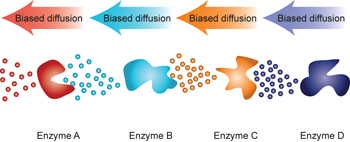
Enzymes that form a metabolic pathway in which the product of one enzyme is the substrate for the next have now been shown to associate through a process of sequential, directed chemotactic movement. The extent of enzyme migration is proportional to the exposure time to the substrate gradient.
|
 |
 |
 |
| Evolving artificial metalloenzymes via random mutagenesis pp318 - 324
Hao Yang, Alan M. Swartz, Hyun June Park, Poonam Srivastava, Ken Ellis-Guardiola et al.
doi:10.1038/nchem.2927
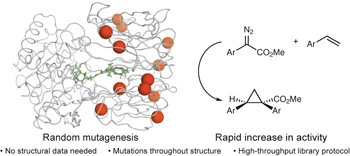
Proteins have the potential to serve as powerful scaffolds that control the catalytic activity and selectivity of organometallic centres; however, new methods are needed to optimize artificial metalloenzymes. Now, an efficient approach for evolving the activity and selectivity of artificial metalloenzymes has been demonstrated using dirhodium cyclopropanases. This approach does not require structural or mechanistic data to guide mutagenesis.
|
 |
 |
 |
| Pt/Cu single-atom alloys as coke-resistant catalysts for efficient C–H activation pp325 - 332
Matthew D. Marcinkowski, Matthew T. Darby, Jilei Liu, Joshua M. Wimble, Felicia R. Lucci et al.
doi:10.1038/nchem.2915
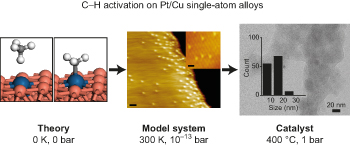
A renewed interest in C–H bond activation has developed on account of the recent increased availability of shale gas. Now, using a combination of surface science, microscopy, theory and nanoparticle studies, the ability of coke-resistant Pt/Cu single-atom alloys to efficiently activate C–H bonds in alkanes has been demonstrated under realistic catalytic conditions.
|
 |
 |
 |
| Palladium-catalysed anti-Markovnikov selective oxidative amination pp333 - 340
Daniel G. Kohler, Samuel N. Gockel, Jennifer L. Kennemur, Peter J. Waller and Kami L. Hull
doi:10.1038/nchem.2904
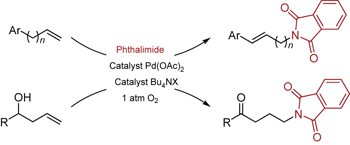
Aminopalladation is a key step in a number of carbon–nitrogen bond-forming processes, but carrying out this step with intermolecular anti-Markovnikov selectivity has remained difficult. Such a process has now been developed by using an anionic palladium catalyst to generate terminal carbon–nitrogen bonds from alkenes.
Chemical compounds |
 |
 |
 |
| Ultrafast dynamics of low-energy electron attachment via a non-valence correlation-bound state pp341 - 346
Joshua P. Rogers, Cate S. Anstöter and Jan R. R. Verlet
doi:10.1038/nchem.2912
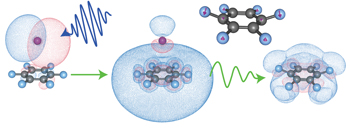
The capture of an electron by a molecule represents one of the most fundamental chemical transformations, but its mechanism at very low energies remains unclear. Now, it is shown that low-energy electron attachment to hexafluorobenzene is mediated by a non-valence correlation-bound state of the anion.
|
 |
 |
 |
| Asymmetric transfer hydrogenation by synthetic catalysts in cancer cells pp347 - 354
James P. C. Coverdale, Isolda Romero-Canelón, Carlos Sanchez-Cano, Guy J. Clarkson, Abraha Habtemariam et al.
doi:10.1038/nchem.2918
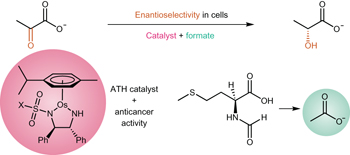
Intracellular asymmetric transfer hydrogenation catalysis using Os(II) complexes has now been demonstrated and offers a new approach for selectively killing cancer cells. Enantiomers of Os(II) arene catalysts can penetrate cell membranes enabling the reduction of pyruvate to D- or L-lactate using formate as a hydride source, with high enantioselectivity.
Chemical compounds |
 |
 |
 |
| Transferring the entatic-state principle to copper photochemistry pp355 - 362
B. Dicke, A. Hoffmann, J. Stanek, M. S. Rampp, B. Grimm-Lebsanft et al.
doi:10.1038/nchem.2916
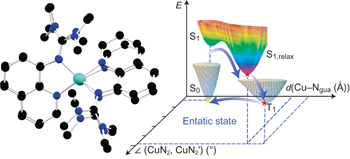
According to the entatic-state principle, distortions of the coordination geometry of a reacting compound can optimize the energies of starting and final states to improve reaction rates. Here, the entatic-state principle is observed to apply to photoactive copper complexes that have a constrained ligand geometry, resulting in very short charge-transfer state lifetimes.
|
 |
 |
 |
| Direct observation of the influence of cardiolipin and antibiotics on lipid II binding to MurJ pp363 - 371
Jani Reddy Bolla, Joshua B. Sauer, Di Wu, Shahid Mehmood, Timothy M. Allison et al.
doi:10.1038/nchem.2919

Most steps in peptidoglycan biosynthesis are understood, but the lipid II binding properties to the flippases MurJ and FtsW remain unknown. Now, it has been shown that lipid II exhibits preferential binding to MurJ, which is modulated by ramoplanin and cardiolipins. These insights into the lipid II binding determinants suggest roles for lipids in regulating substrate binding.
|
 |
| Advertisement |
 |
| A new open access, multi-and interdisciplinary journal dedicated to publishing the finest research on both microbial biofilms and microbiomes, the journal is now open for submissions. |  | | |
 |
| |
In Your Element |  Top Top |
 |
 |
 |
| Rounding up lutetium p372
Lars Ohrstrom
doi:10.1038/nchem.2938
Lars Ohrstrom suspects that as time goes by, we may see more of lutetium — the last of the lanthanoids.
|
 |
 Top Top |
 |
 |
 |  |  |  |  |  | Natureevents is a fully searchable, multi-disciplinary database designed to maximise exposure for events organisers. The contents of the Natureevents Directory are now live. The digital version is available here.
Find the latest scientific conferences, courses, meetings and symposia on natureevents.com. For event advertising opportunities across the Nature Publishing Group portfolio please contact natureevents@nature.com |  |  |  |  |  | |
 |


No comments:
Post a Comment